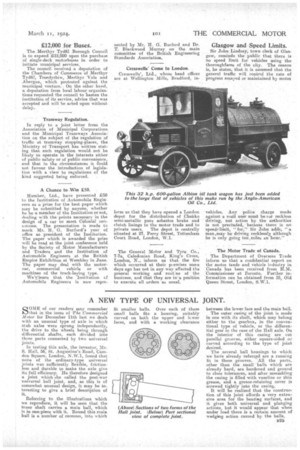A NEW TYPE OF UNIVERSAL JOINT.
Page 9

If you've noticed an error in this article please click here to report it so we can fix it.
SOME of our readers may remember that in the issue of The Commercial Motor for December 11th last we dealt with an unusual type of axle in which stub axles were sprung independently, the drive to the wheels being through differential shafts, each divided into three parts connected by two universal joints.
• In testing this axle, the inventor, Mr. S. Hall, 56, St. Augustine's Road, Camden Square, London, N.W.1, found that none of the ordinary-type universal joints was sufficiently flexible, frictionless and durable to make the axle give its full efficiency. He therefore designed a joint which he called the post-war universal bail joint, and, as this is of somewhat unusual design, it may be interesting to give a brief description of it.
Referring to the illustrations which we reproduce, it will be seen that the Inner shalt carries a main ball, which is in one;piece with it. Round this maia ball is a number of recesses, into rhich fit smaller balls. Over each of these small balls fits a housing, suitably curved on both the upper and lcwer faces, and with a working clearance between the lower face and the main ball.
The outer casing of the joint is made in one with its shaft, which may belong either to the gearbox, in the conventional type of vehicle, or the differential gear in the case of the Hall axle. On the interior of this casing are cut parallel grooves, either square-sided or curved according to the type of joint desired.
The .several ball housings to which we haVe already ref err.ed are a running fit, in these grooves. All the parts, other than the small balls which are already hard, are hardened and ground to close tolerances, and after assembling the casing is filled with vaseiine or thin grease, and a grease-retaining cover is screwed tightly into the casing.
It will be realized that the construction of this joint affords a very extensive area for the bearing surfaces, and it gives both universal and plunging actions, but it would appear that when under load there is a certain amount of wedging action caused by the
































